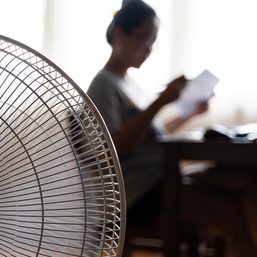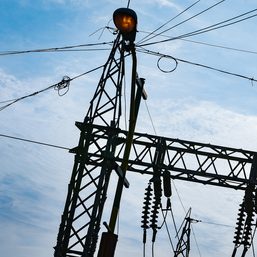SUMMARY
This is AI generated summarization, which may have errors. For context, always refer to the full article.

BACOLOD, Philippines – Visayas needs at least 250 megawatts more to prevent power outages from taking place, a Department of Energy (DOE) official said on Tuesday, April 23.
The official, Engineer Joey Rey Malleza, head of the DOE’s Industry Management Division in Visayas, gave the stark warning even as he stressed that an immediate 10% boost in generated power could stave off blackouts, citing a surge in demand that threatens the region’s power stability.
The increase in requirement of as much as 10% is based on an annual increase in peak demand of more than 9% in the Visayas. The projection is being updated annually.
From 2022 to 2023, he said, Visayas saw a 9.36% spike in peak demand, and as of April 22, the afternoon demand reached 2,469 MW, with the evening demand slightly lower at 2,290 MW.
“We are currently operating with a negative operating margin of approximately 35 MW in the evening, which needs to be sourced externally, either from the Luzon or Mindanao grids,” Malleza said.
He attributed recent alert levels in the power grid to the substantial uptick in power demand, exacerbated by unplanned outages and power plants’ reduced capacities across the Visayas.
Malleza said about a dozen power plants in the Visayas experienced unplanned outages, while seven others underwent derating due to various reasons, including technical issues, fuel shortages, and maintenance operations.
However, he clarified that the outages did not occur simultaneously but took place on separate occasions over the past several days.
“Some of these have since returned to service during the weekend. Also, some of the plants are in reduced output due to plant age, low steam capacity from geothermal sources, scheduled maintenance, among others,” he said.
Projected demand
According to Malleza, projections from the Philippine Energy Plan indicate that by 2030, Visayas will require a power-generating capacity ranging from 4,423 MW to 4,495 MW to meet its needs.
In response to the situation, he said the energy department is closely coordinating with the National Grid Corporation of the Philippines (NGCP) and generation companies to minimize power interruptions.
Malleza urged all stakeholders to adhere to the Grid Operating and Maintenance Program (GOMP) for efficient scheduling of repairs and maintenance.
The DOE has also reiterated its call for public cooperation in reducing power consumption, particularly during peak hours, through energy conservation practices.
Power sources
Expressing concern, Negros Occidental Governor Eugenio Jose Lacson called for more investments in renewable energy projects in the province.
Lacson has been emphasizing the provincial government’s commitment to clean and sustainable energy, positioning Negros Occidental as a leading advocate for green initiatives.
However, Frank Carbon, chief executive officer of the Metro Bacolod Chamber of Commerce and Industry (MBCCI), said there was a critical need for new power-generating plants, both fossil-based and renewable, to address the escalating power demand in Visayas.
He said baseload power plants should complement renewable energy sources to ensure a stable and reliable power supply for the entire Visayas region.
Carbon also raised questions about the status of the Mindanao-Visayas Interconnection Project (MVIP), urging authorities to tap the Mindanao power grid that is enjoying excess power.
“It is said that it can transmit around 450 MW of power from Mindanao. So, what happened? Where’s Mindanao’s excess power right now?” Carbon asked.
Same problem in Luzon
Luzon is also facing a similar problem, prompting Senator Risa Hontiveros to call on the DOE to provide a lasting solution.
“We’ve had enough. Paulit-ulit ang pagkukulang ng NGCP. Ang kuryente, pampagaan yan ng buhay, hindi pampabigat. Kailangan na natin ng isang totoo at sustainable na solusyon sa harap ng sabay-sabay na outages ng mahigit 20 planta,” read part of a statement released by Hontiveros’ office on Tuesday.
(We’ve had enough. The shortcomings of the NGCP are becoming repetitive. Electricity should lighten our lives, not weigh us down. We need a genuine and sustainable solution in the face of simultaneous outages affecting over 20 plants.)
Citing NGCP data, Hontiveros said some 2,325 MW of electricity is currently unavailable as 22 power plants are undergoing forced outages, with another operating on derated capacity.
She noted that these alerts are frequently attributed to malfunctioning power plants and dwindling reserves.
“Paanong naging sabay-sabay yung mga outages ng mahigit 20 planta? At sasabihin lahat ng yun ay unplanned outages? Kung hindi nila yan maipaliwanag, hindi na rin nakakapagtaka na paikot-ikot at paulit-ulit ang problemang ito,” Hontiveros said.
(How did over 20 plants experience outages simultaneously? And are they claiming all of these are unplanned outages? If they can’t explain that, it’s no wonder this problem keeps going in circles.)
Hontiveros demanded a clear explanation from the energy department as consumers endure rotational outages and higher power bills. –Rappler.com
Add a comment
How does this make you feel?







![[ANALYSIS] Panay blackouts](https://www.rappler.com/tachyon/2024/03/panay-blackouts.jpg?resize=257%2C257&crop=277px%2C0px%2C720px%2C720px)











There are no comments yet. Add your comment to start the conversation.